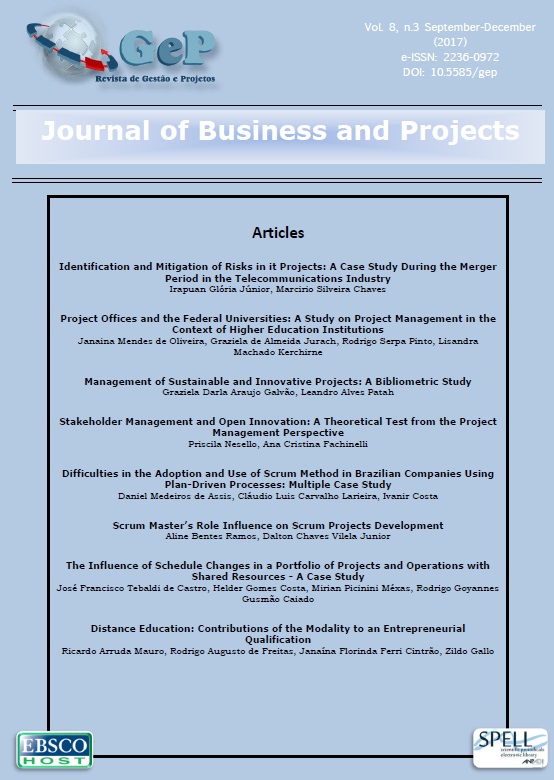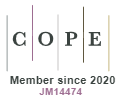Scrum Master’s Role Influence on Scrum Projects Development
DOI:
https://doi.org/10.5585/gep.v8i3.556Keywords:
Scrum, Scrum Master, Team, Manager Role.Abstract
Scrum is an agile management framework whose role of the Scrum Master is the object of study of this research. This article aims to analyze the influence of the role of the Scrum Master in the development of Scrum projects. The research is characterized as qualitative, with a character of explanatory study and strategy of case study through the observation of the application of Scrum projects in three organizations of information technology development and innovation in Amazonas. Data collection consisted of a qualitative step, through semi-structured interviews, and a quantitative one, via an electronic form. These were analyzed by means of a comparison between managerial roles and the Scrum Master characteristics foreseen in the specialized literature. Results show the combination of profiles with the use of aspects of project management according to the PMBOK, which generate numerous benefits for the different realities studied.
References
Åkervall, N. & Linder, A. (2009). Applying project methodology in agile development. Paper presented at PMI® Global Congress 2009—EMEA, Amsterdam, North Holland, The Netherlands. Newtown Square, PA: Project Management Institute.
Antunes, B., Santos, D., Lopes, E., Fidalgo, F., & Alves, P. (2015). Blisstrail: An Agile Project Business Case Study. In Procedia Computer Science (Vol. 64, pp. 529–536). https://doi.org/10.1016/j.procs.2015.08.558
Bardin, L. (2011). Análise de conteúdo. (L. A. Reto, Trad.) São Paulo: Edições 70.
Bennison, P. (2008). Agile and PMBOK® guide project management techniques: closer than you think. Paper presented at PMI® Global Congress 2008—North America, Denver, CO. Newtown Square, PA: Project Management Institute.
Bernardo, J. H., Dias Jr, J. L., & Cunha, J. O. (17-20 de Maio de 2016). Atribuições e competências individuais do Scrum Master: um estudo exploratório. XII Brazilian Symposium on Information System.
Blom, M. (2010). Is scrum and XP suitable for CSE development? In Procedia Computer Science (Vol. 1, pp. 1511–1517). https://doi.org/10.1016/j.procs.2010.04.168
Cobb, C. G. (2011). Appendix B: Overview of Agile Project Delivery Frameworks. In SBIE - Simpósio Brasileiro de Informática na Educação (pp. 211–233). Hoboken, NJ, USA: John Wiley & Sons, Inc. https://doi.org/10.1002/9781118085950.app2
Cockburn, A., Beck, K., Beedle, M., Bennekum, A., Cunningham, W., Fowler, M., . . . Thomas, D. (2001). Manifesto para o desenvolvimento ágil de software. Acesso em 4 de Dezembro de 2016, disponível em Manifesto ágil: http://www.manifestoagil.com.br/
Cooper, R. G., & Sommer, A. F. (2016). Agile-Stage-Gate: New idea-to-launch method for manufactured new products is faster, more responsive. Industrial Marketing Management, 59, 167–180. https://doi.org/10.1016/J.INDMARMAN.2016.10.006
Davidson, A., & Klemme, L. (2016). Why a CEO should think like a Scrum Master. Strategy & Leadership, 44(1), 36–40. https://doi.org/10.1108/SL-11-2015-0086
Dingsøyr, T., Nerur, S., Balijepally, V., & Moe, N. B. (2012). A decade of agile methodologies: Towards explaining agile software development. Journal of Systems and Software, 85(6), 1213–1221. https://doi.org/10.1016/j.jss.2012.02.033
Heikkilä, V. T., Paasivaara, M., Rautiainen, K., Lassenius, C., Toivola, T., & Järvinen, J. (2015). Operational release planning in large-scale scrum with multiple stakeholders - A longitudinal case study at F-secure corporation. In Information and Software Technology (Vol. 57, pp. 116–140). https://doi.org/10.1016/j.infsof.2014.09.005
Hilt, M. J., Wagner, D., Osterlehner, V., & Kampker, A. (2016). Agile Predevelopment of Production Technologies for Electric Energy Storage Systems – A Case Study in the Automotive Industry. Procedia CIRP, 50, 88–93. https://doi.org/10.1016/j.procir.2016.04.189
Lesnevsky, A. S. (2007). Enriching PMBOK® Guide by practices and techniques of agile project management of software development. Paper presented at PMI® Global Congress 2007—EMEA, Budapest, Hungary. Newtown Square, PA: Project Management Institute.
Massari, V. (2016). Agile Scrum Master no Gerenciamento Avançado de Projetos. Brasport.
Maximini, D. (2015). The Scrum Culture: Introducing Agile Methods in Organizations. Springer.
McKenrick, C. R. (2011). Agile project management with formal requirements and test case management. Paper presented at PMI® Global Congress 2011—North America, Dallas, TX. Newtown Square, PA: Project Management Institute.
Nidagundi, P., & Novickis, L. (2017). ScienceDirect Introducing Lean Canvas Model Adaptation in the Scrum Software Testing. Procedia Computer Science, 104, 97–103. https://doi.org/10.1016/j.procs.2017.01.078
Orłowski, C., Bach-Dąbrowska, I., Kapłański, P., & Wysocki, W. (2014). Hybrid fuzzy-ontological project framework of a team work simulation system. In Procedia Computer Science (Vol. 35, pp. 1175–1184). https://doi.org/10.1016/j.procs.2014.08.214
Paschek, D., Rennung, F., Trusculescu, A., & Draghici, A. (2016). Corporate Development with Agile Business Process Modeling as a Key Success Factor. Procedia Computer Science, 100(0), 1168–1175. https://doi.org/10.1016/j.procs.2016.09.273
Prodanov, C., & Freitas, E. d. (2013). Metodologia do trabalho científico (2a ed.). Nova Hamburgo: Feevale.
Project Management Institute. (2013). A Guide to the Project Management Body of Knowledge (PMBOK® Guide) (5th ed.).
Quinn, R., Faermais, S., McGrath, M., & Thompson, M. (2004). Competências gerenciais: princípios e aplicações. (C. d. Serra, Trad.) Rio de Janeiro: Elsevier.
Rising, L., & Janoff, N. S. (2000). The Scrum software development process for small teams. IEEE software, 17(4), pp. 26-32. doi:10.1109/52.854065
Rodriguez, G., Soria, Á., & Campo, M. (2015). Virtual Scrum: A teaching aid to introduce undergraduate software engineering students to Scrum. Computer Applications in Engineering Education, 23(1), 147–156. https://doi.org/10.1002/cae.21588
Rubin, K. S. (2012). Essential Scrum: A practical guide to the most popular Agile process. Addison-Wesley.
Sabbagh, R. (2013). Gestão ágil para projetos de sucesso. São Paulo: Casa do Código.
Sanjuan, A. G., & Froese, T. (2013). The Application of Project Management Standards and Success Factors to the Development of a Project Management Assessment Tool. Procedia - Social and Behavioral Sciences, 74, 91–100. https://doi.org/10.1016/j.sbspro.2013.03.035
Sauder, L. (2011). Uso do mural de Gantt para acompanhar tarefas em um ambiente ágil. Livraria Virtual PMI.
Schwaber, Ken, & Sutherland, J. (2016). Um guia definitivo para o Scrum: as regras do jogo. Acesso em 4 de Dezembro de 2016, disponível em Scrum Guides: http://scrumguides.org/docs/scrumguide/v2016/2016-Scrum-Guide-Portuguese-Brazilian.pdf
Schwarz, R., Davidson, A., Carlson, P., & McKinney, S. (2005). The skilled facilitator fieldbook: tips, tools and tested methods for consultants, facilitators, managers, trainers, and coaches. San Francisco, California: Jossey-Bass.
Scrum Alliance. (s.d.). Scrum Alliance. Acesso em 4 de Dezembro de 2016, disponível em Scrum Alliance: https://www.scrumalliance.org/
SCRUMstudy. (2016). Um Guia para o Conhecimento em Scrum (Guia SBOK™). SCRUMstudy.
Shrivastava, S. V., & Rathod, U. (2014). Risks in Distributed Agile Development: A Review. Procedia - Social and Behavioral Sciences, 133, 417–424. https://doi.org/10.1016/j.sbspro.2014.04.208
Silva, E. C., & Lovato, L. A. (Maio/Agosto de 2016). Framework Scrum: eficiência em projetos de software. Revista de Gestão de Projetos, 7(2).
Silva, R. F., & Melo, F. C. (Setembro/Dezembro de 2016). Modelos Híbridos de Gestão de Projetos Como Estratégia na Condução de Soluções em Cenários Dinâmicos e Competitivos. Revista Brasileira de Gestão e Desenvolvimento Regional, 12(3), 443-457.
Sliger, M. (2008). Agile project management and the PMBOK® guide. Paper presented at PMI® Global Congress 2008—North America, Denver, CO. Newtown Square, PA: Project Management Institute.
Sliger, M. (2011). Agile project management with Scrum. Paper presented at PMI® Global Congress 2011—North America, Dallas, TX. Newtown Square, PA: Project Management Institute.
Soares, M. S. (2004). Metodologias ágeis extreme programming e Scrum para o desenvolvimento de software. Revista Eletrônica de Sistemas de Informação, 3, 8-13.
Streule, T., Miserini, N., Bartlomé, O., Klippel, M., & De Soto, B. G. (2016). Implementation of Scrum in the Construction Industry. In Procedia Engineering (Vol. 164, pp. 269–276). https://doi.org/10.1016/j.proeng.2016.11.619
Sverrisdottir, H. S., Ingason, H. T., & Jonasson, H. I. (2014). The Role of the Product Owner in Scrum-comparison between Theory and Practices. Procedia - Social and Behavioral Sciences, 119, 257–267. https://doi.org/10.1016/j.sbspro.2014.03.030
Williams, L. (2012). What agile teams think of agile principles. Communications of the ACM, 55(4), 71. https://doi.org/10.1145/2133806.2133823
Downloads
Published
How to Cite
Issue
Section
- Abstract 1719
- PDF (Português (Brasil)) 1544








